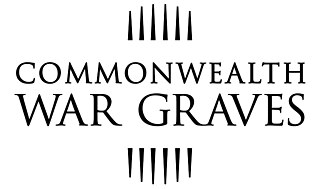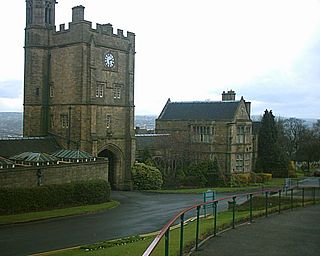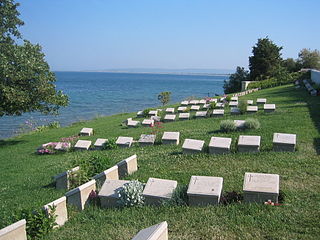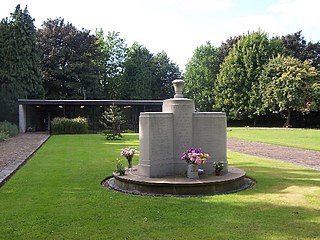Related Research Articles

The Commonwealth War Graves Commission (CWGC) is an intergovernmental organisation of six independent member states whose principal function is to mark, record and maintain the graves and places of commemoration of Commonwealth of Nations military service members who died in the two World Wars. The commission is also responsible for commemorating Commonwealth civilians who died as a result of enemy action during the Second World War. The commission was founded by Sir Fabian Ware and constituted through Royal Charter in 1917 as the Imperial War Graves Commission. The change to the present name took place in 1960.

The City Road Cemetery is a cemetery in the City of Sheffield, England that opened in May 1881 and was originally Intake Road Cemetery. Covering 100 acres (40 ha) it is the largest and is the head office for all the municipally owned cemeteries in Sheffield. The cemetery contains Sheffield Crematorium, whose first cremation was on 24 April 1905.

Cape Helles is the rocky headland at the southwesternmost tip of the Gallipoli peninsula, Turkey. It was the scene of heavy fighting between Ottoman Turkish and British troops during the landing at Cape Helles at the beginning of the Gallipoli campaign in 1915. The name derives from the Greek Helle; Helles means "Helle's" in Greek.

Beach Cemetery is a small Commonwealth War Graves Commission cemetery containing the remains of allied troops who died during the Battle of Gallipoli. It is located at Hell Spit, at the southern end of Anzac Cove on the Gallipoli Peninsula.

Gosnay is a commune in the Pas-de-Calais department in the Hauts-de-France region of France.

Quinn's Post Cemetery is a Commonwealth War Graves Commission cemetery from World War I in the former Anzac sector of the Gallipoli Peninsula, Turkey. The battles at Gallipoli, some of whose participating soldiers are buried at this cemetery, were an eight-month campaign fought by Commonwealth and French forces against Turkish forces in an attempt to force Turkey out of the war, to relieve the deadlock of the Western Front (France/Belgium) and to open a supply route to Russia through the Dardanelles and the Black Sea.

Wakapuaka Cemetery is a cemetery located in Brooklands, Nelson, New Zealand. "Wakapuaka" is Māori for "heaps of aka leaves".

Madras War Cemetery is located in Nandambakkam, Chennai, Tamil Nadu, India. It was created to receive Second World War graves from civil and cantonment cemeteries in the south and east of India where their permanent maintenance could not be assured.

Plugge's Plateau Cemetery is the smallest Commonwealth War Graves Commission cemetery on the Gallipoli Peninsula in Turkey. It contains some of soldiers killed during World War I during the battles at Gallipoli, was an eight-month campaign fought by Commonwealth and French forces against Turkish forces in an attempt to force Turkey out of the war, to relieve the deadlock of the Western Front (France/Belgium) and to open a supply route to Russia through the Dardanelles and the Black Sea.

Hill 60 Cemetery is a Commonwealth War Graves Commission cemetery dating from World War I at the Northern end of the former Anzac sector of the Gallipoli Peninsula, Turkey and the location of Hill 60 Memorial, one of four memorials on the peninsula which commemorate New Zealanders killed in the campaign but who have no known grave.

Johnston's Jolly Cemetery is a Commonwealth War Graves Commission cemetery containing the remains of some of the Allied troops who died during the Battle of Gallipoli.

New Zealand No.2 Outpost Cemetery is a small Commonwealth War Graves Commission cemetery containing the remains of some of the Allied troops who died during the Battle of Gallipoli.

Courtney's and Steel's Post Cemetery is a Commonwealth War Graves Commission cemetery located near ANZAC Cove on the Gallipoli peninsula in Turkey. It contains the graves of some of the former British Empire troops who died during the Gallipoli Campaign.
The Farm Cemetery is a Commonwealth War Graves Commission cemetery on the Gallipoli Peninsula in Turkey. It contains the remains of some of the soldiers killed during World War I in the Battles at Gallipoli.
Lala Baba Cemetery is a Commonwealth War Graves Commission cemetery on the Gallipoli Peninsula in Turkey. It contains the remains of some of the soldiers killed during World War I during the battles at Gallipoli. This was an eight-month campaign fought by Commonwealth and French forces against Ottoman Empire forces to try to force the Ottoman Empire out of the war which it was hoped would open a supply route from the Mediterranean to Russia through the Dardanelles and Istanbul and to relieve the deadlock on the Western Front.
Knightsbridge War Cemetery is a war cemetery located in Acroma, Libya, located 750 metres south of the main road from Benghazi to Tobruk, 25 km (16 mi) west of Tobruk. The cemetery is situated in open country, the Cross of Sacrifice is set high above the level of the cemetery and is easily seen from the road. The cemetery is reached from a track branching off the main road.

The South Stoneham municipal cemetery, situated off Mansbridge Road, Southampton, was opened in early 1905, with the first burial taking place on 4 February, and was extended in 1927. The South Stoneham Crematorium was located north of the cemetery but demolished during 1973 to make way for the construction of the M27 motorway. The South Stoneham garden of remembrance is now located at the north end of the cemetery.

Cambridge City Cemetery is the main burial ground for the city of Cambridge in Cambridgeshire. It is to the north of the city, at the junction of Newmarket Road and Ditton Lane, near to Cambridge Airport.
The Archangel Allied Cemetery is a military cemetery in Archangel, Russia, that is under the management of the Commonwealth War Graves Commission. Amongst the buried is Samuel George Pearse, an Australian soldier who received the Victoria Cross during the 1919 North Russia intervention in the Russian Civil War.
References
- Cemetery details . Commonwealth War Graves Commission .
- "Canterbury Cemetery". Battlefields 1914–1918. Retrieved 2008-07-30.